
Bornella anguilla
Johnson, 1984
Order: NUDIBRANCHIA
Suborder: DENDRONOTINA
Family: Bornellidae
DISTRIBUTION
Indo-West Pacific.
PHOTO
Scottburgh - 20m - south coast KwaZulu-Natal, SOUTH AFRICA. 21 May 2000. Size: 80mm. Photo of head. PHOTO: Valda Fraser
Relatively large species of Bornella, growing up to 80mm. It has a very characteristic mosaic-like colour pattern. Its name [anguilla = eel] refers to its method of swimming. while most species of Bornella can swim by a lateral flexion of their body, in B. anguilla a muscular wave travels down the body to produce an eel-like motion. it is reported by Johnson to feed on the hydroid Plumularia.
Reference:
• Johnson, S. (1984) A new Indo-West pacific species of the dendronotacean nudibranch Bornella (Mollusca: Opisthobranchia) with anguilliform swimming behaviour. Micronesica, 19(1): 17-26. [for 1983]
Rudman, W.B., 2000 (May 27) Bornella anguilla Johnson, 1984. [In] Sea Slug Forum. Australian Museum, Sydney. Available from http://www.seaslugforum.net/find/bornangu
Related messages
Juvenile Bornella anguilla from East Timor
January 13, 2009
From: Brian Francisco
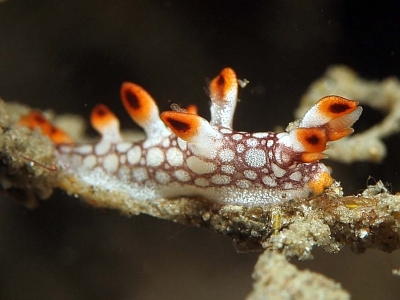
Concerning message #20964:
Hi Bill
My best guess is that this is a juvenile Bornella anguilla. It was less than 1cm, but I think I can see the development of gills along the first cerata.
Locality: Christmas Beach, 12 meters, East Timor, Banda Sea, 25 December 2008, coral reef. Length: 1 cm. Photographer: Brian Francisco.
Brian
francisco.brian@gmail.com

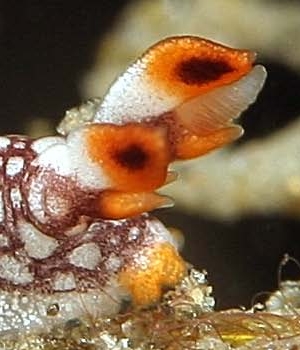
Dear Brian,
Yes you can see the transparent gills on the inside of the first cerata. As you can see in other photos of larger animals on the Forum , the gills in Bornella anguilla are probably the most developed of any species of Bornella. I have also included a close-up of the rhinophore complex showing how the stalk and sheath have grown to look almost identical to the cerata.
Best wishes,
Bill Rudman
Bornella anguilla feasts upon hydroids
October 30, 2007
From: David Mullins
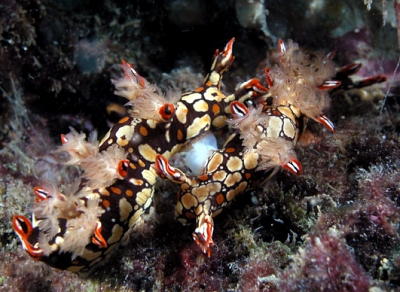
Dear Bill,
Here are some pics of Bornella anguilla feeding and mating.
I have taken the feeding pics from the opposite side of the hydroid to the nudibranch. In one pic [middle left] as it approaches the hydroid the polyps at the top at the end of the stem can be observed to still be expanded unaware of their fate. In the second pic [middle right ] it is possible to see the extended buccal bulb and the branches of the hydroid being drawn into the mouth to be stripped of its polyps.
Locality: Old Woman Island, Maroochydore, Sunshine Coast, 12 metres, Queensland, Australia., Pacific Ocean., 14 October 2007, Rocky reef. Length: 70 mm. Photographer: David Mullins.
This species has been so prolific at this particular site at Old Woman Island that we have named the site "Bornella Reef" (just for our own convenience of course).
Also I must add that this is the only species of hydroid that I have observed Bornella anguilla eating here on the Sunshine Coast.
Hoping that this is of use to the forum,
Kind regards,
David Mullins.
david@nudibranch.com.au

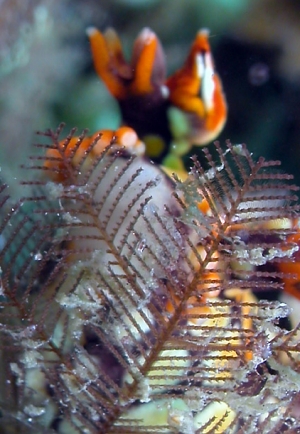

Dear David,
Thanks for these interesting pictures. Hopefully a expert on hydroids can identify this colony from the rather characteristic colony structure. It is always useful in cases like this to send a high resolution photo so I can include a 'closeup' showing the detailed structure of the colony.
I have included alongside a close-up to show the extended polyps you mention.
Best wishes,
Bill Rudman
Bornella anguilla swimming
November 29, 2006
From: Michael Henke

Dear Bill,
I am not sure, that this nudi is a Bornella stellifer. Can you confirm or correct me please.
Locality: P. Talise, 10 m, Nord Sulawesi, Indo Pacific, 2 November 2006, drop off, coral wall. Length: 12 cm. Photographer: Michael Henke.
I found it on two night dives at the 2 and 6 of November 2006 near P. Talise (Nord Sulawesi) in about 10 m depth (wall dive). The crazy thing was that this nudi can swim like a snake so that we call it nudi-fish, but I don't think that's the right name. The speed was really incredible, aboot 0,8 m per second in horizontally direction. Do you know if other nudis can swim like this?
PS Great website, it help me to identify most of my nudi-pictures!
Thanks,
Michael
henke@seddoc.de
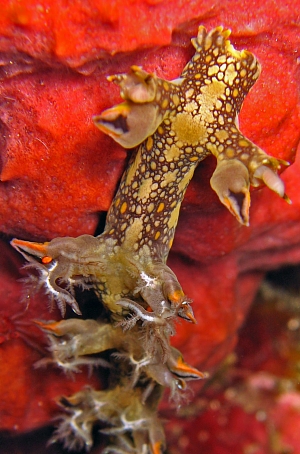
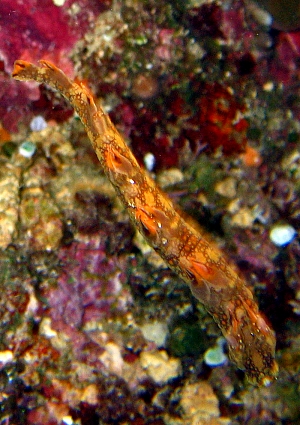
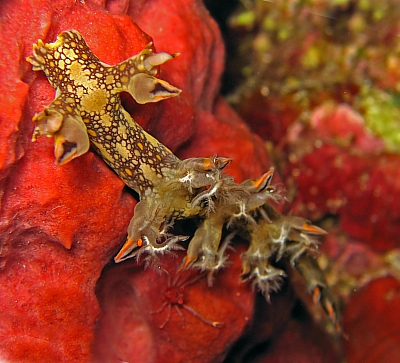
Dear Mike,
It's definitely a species of Bornella, but not B. stellifer. This species is reknowned for the swimming ability you witnessed. In fact it got its name, Bornella anguilla, from its ability to swim like an eel [anguilla = eel]. Other species of Bornella swim by lateral flexion of their whole body, flexing their body one way, and then the other, causing them to swim sidweways through the water. In B. anguilla on the other hand the whole body forms a wave, like in an eel or snake, which allows it to swim head first through the water. As your photo shows, the cerata, gills and rhinophores all fold in to streamline the body.
Concerning information on swimming in other sea slugs. I have a poor excuse for a Fact Sheet on swimming, but if you follow my suggestion there and do a search on the Forum for swimming you'll find quite a few examples.
Best wishes,
Bill Rudman
Bornella anguilla from Sulawesi
November 29, 2006
From: Mike Krampf

Just thought I'd share a couple of pics showing color variations of Bornella anguilla. The first one (6 -7 cm) was much larger than the second (3 -4 cm) one.
Locality: Bangka Island, 50 ft, Sulawesi, Indonesia, Celebes Sea, 23 October 2006, Fringing reef. Length: 6-7 cm. Photographer: Mike Krampf.
Mike
mtkrampf@yahoo.com
Krampf, M., 2006 (Nov 29) Bornella anguilla from Sulawesi. [Message in] Sea Slug Forum. Australian Museum, Sydney. Available from http://www.seaslugforum.net/find/18590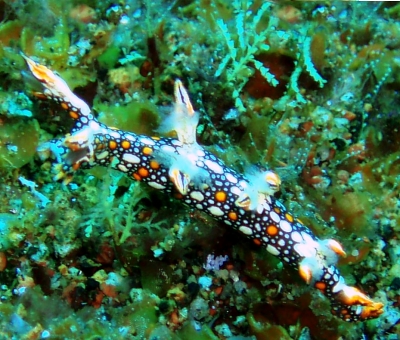
Dear Mike,
The colour of this species is quite spectacular. It always makes me think of a Roman mosaic. The smaller one in the lower photo, seems to have found a banquet. The area its crawling over seems to be covered in hydroids, which are the food of species of Bornella. What we don't know is whether they eat all hydroids or specialise on one or a few species.
Best wishes,
Bill Rudman
Bornella anguilla from the Philippines
July 8, 2006
From: Terry Adriance

I am hoping that you will be able to identify this nudibranch.
Locality: El Nido, North Palawan, 5 feet, Philippines, 5 May 2006, intertidal? Shallow w/ surge. Length: 3 or 4 inches?. Photographer: Terry Adriance.
Terry Adriance
adriancet@aol.com
Adriance, T., 2006 (Jul 8) Bornella anguilla from the Philippines. [Message in] Sea Slug Forum. Australian Museum, Sydney. Available from http://www.seaslugforum.net/find/16854Dear Terry,
This is Bornella anguilla. If you have a look at the Fact Sheet and other messages you will see that the name anguilla [= eel] comes from its habit, when startled, of swimming with a sinuous eel-like motion.
I guess you won't mind if I don't post your later 'thanks for nothing' message which you sent because I didn't reply quickly enough for you. I am afraid I receive on average 10 messages a day and although I would like to, I can't physically answer that many every day. I am trying to recruit some 'helpers' but essentially I do this myself, in my own time. I explain there is a chance your message won't be posted in the Instructions on sending messages page. If in the future you wish to inquire about the fate of a message all you need to do is ask nicely and quote the message number which is sent to you as an acknowledgement.
Best wishes,
Bill Rudman
Bornella anguilla from Thailand
February 8, 2006
From: Craig Beasley
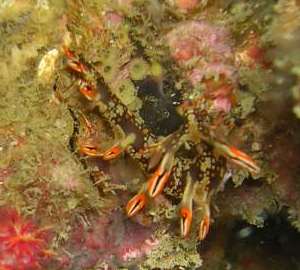

Here is one I have never seen before -- wondering if you know what it is. The second image is not a nudibranch I guess, but I also have no idea what it is. Just curious.
PS not a very good photo of the slug -- he/she was not being very cooperative.
Locality: Shark Point, Koh Phi Phi, Thailand, Andaman Sea. Depth: 20 m. Length: 3-4 inches? not sure. 10 April 2005. Photographer: Craig Beasley
Thanks.
Craig
craigbzly@swbell.net
Beasley, C. J., 2006 (Feb 8) Bornella anguilla from Thailand. [Message in] Sea Slug Forum. Australian Museum, Sydney. Available from http://www.seaslugforum.net/find/15697Dear Craig,
Your upper photo is Bornella anguilla, so named because it can swim like an eel. The lower one is indeed a nudibranch - you can see a pair of black rhinophores on the right end of the animal. It is most probably Phyllidiella nigra.
Could I make a general comment about multiple species in one message. Normally I won't post 'mixed messages'. By restricting messages to a single species I can tie the messages to a specific Fact Sheet and make cross-referencing easier for everyone. This is not to say that if you have a message about one slug eating another, that two species in a message is not appropriate, but I think you will all understand what I am trying to do.
More importantly, it is quite time-consuming for me to split up messages with mutiple species in them, so when I am pressed for time, these messages tend to get left to one side.
Best wishes,
Bill Rudman
Bornella anguilla from Reunion Island
February 16, 2005
From: Philibert Bidgrain
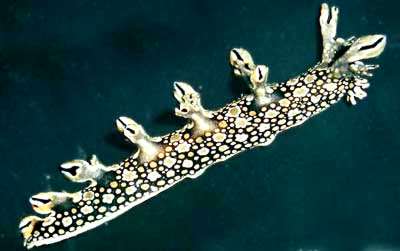
Dear Bill,
Reunion Island sea slugs:
We have only two specimens of this species, observed and photographed by Maurice Jay a few years ago... It seems to be a specimen of Bornella anguilla
Best Regards
Philibert Bidgrain
http://vieoceane.free.fr/runseaslug/indexslug.htm
pbidgrain@yahoo.fr
Bidgrain, P., 2005 (Feb 16) Bornella anguilla from Reunion Island. [Message in] Sea Slug Forum. Australian Museum, Sydney. Available from http://www.seaslugforum.net/find/13094Dear Philibert,
Yes this is Bornella anguilla.
Best wishes,
Bill Rudman
Bornella anguilla from Reunion Is.
July 31, 2003
From: Yves Coze
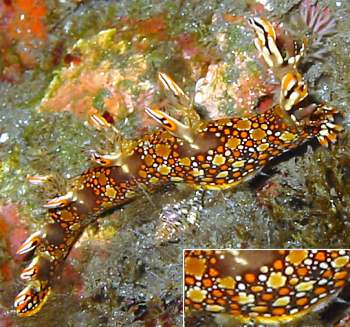
Hello,
While diving last Saturday, I managed to catch a photograph of a sea slug I can't identify. This picture was taken in Réunion Island (Indian Ocean), at a 15 m depth.
With a first search I managed to identify a Flabellina, but I can't get any more info. Could you please help me? This slug was seen "swimming" in the water, it's "tail" undulating very gracefully, after a few cms, it got back to the rocky/coral ground.
It was the first time I spotted it, I'll go back in that place to see if there are any more.
Thank's in advance for your help.
Yves Coze
info@rando-reunion.com
Coze, Y., 2003 (Jul 31) Bornella anguilla from Reunion Is.. [Message in] Sea Slug Forum. Australian Museum, Sydney. Available from http://www.seaslugforum.net/find/10608Dear Yves,
This spectacular animal is Bornella anguilla, the name anguilla being based on its eel-like swimming motion which you noticed. Any other opisthobranch finds you have from Reunion Island would be of great interest as we still have a lot to learn about these animals in the Indian Ocean
Best wishes,
Bill Rudman
Bornella anguilla from Burma (Myanmar)
April 2, 2003
From: Orhan Aytur

Hi Bill,
Here are three photographs of Bornella anguilla from Burma (Myanmar). Certainly an interesting looking animal.
Date: January 2003
Dive site: Black Rock
Location: Mergui Islands, Burma (Myanmar)
Depth: 12-15m
Cheers,
Orhan
aytur@ee.bilkent.edu.tr

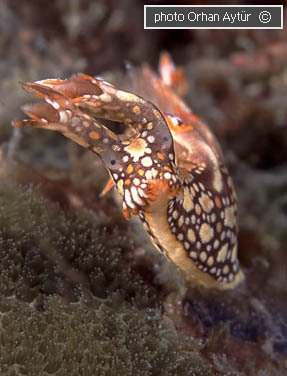
Thanks Orhan,
Bill Rudman
Bornella anguilla from Burma
March 22, 2003
From: Mary Jane Adams
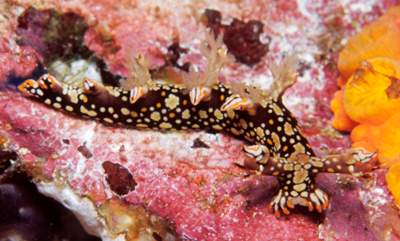
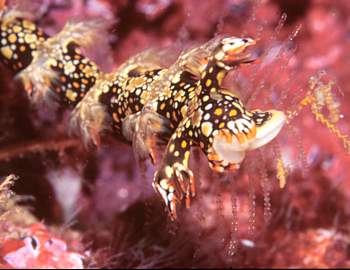
Hi Bill,
I photographed several Bornella anguilla during my recent trip to
the Andaman Sea. What a strange looking animal! It looks like it was designed by a committee. I can see how the multi-colored spots would be an advantage in camouflaging the slug from predators. It certainly
makes them difficult to photograph. I can also imagine that dividing up the gills into several bunches might help it survive a single fish nip. But how did the eyes get in front of the rhinophores instead of
behind them as in other nudibranchs? Where is the anus?
I watched the Bornella in the upper photo crawling around for half a dive. When it reached the edge of a crevice, it slid off and did it's namesake eel-like swim for a few seconds until it reached the other side. Depth: 10 meters, Divesite: Black Rock, Mergui Archipelago, Andaman Sea, Myanmar, Feb. 15, 2003.
The slug in the lower photo has climbed out on a limb, literally, to
feed on a feathery hydroid. Depth: 7 meters, Three Islets, Mergui Archipelago, Andaman Sea, Myanmar, Feb. 27, 2003.
Best regards,
Mary Jane
divepng@yahoo.com
Adams, M.J., 2003 (Mar 22) Bornella anguilla from Burma. [Message in] Sea Slug Forum. Australian Museum, Sydney. Available from http://www.seaslugforum.net/find/9438Thanks Mary Jane.
They are strangely coloured animals, Specimens with the most elaborate colour pattern look like mosaic tiles. The secondary gills in these animals are associated with the paired 'cerata', similar to the small gills found in some species of Doto. I'll have to pass on the position of the eyes. I'm not sure if all dendronotoideans have their eyes in front of the rhinophores or not. I'll have to check for you. Concerning the anus. It opens on the right side just below and between the first and second cerata. The reproductive opening is further forward on the right side, below and between the rhinophore and the first ceras.
Best wishes,
Bill Rudman
Bornella anguilla - date of publication
March 22, 2003
From: Bill Rudman
On the Forum I have had the publication date of this species as 1983, which is what appears on the paper as the journal's publication date [December 1983]. However I have a handwritten note on my reprint of the article which says 'published Jan 1985'. A quick web search shows that 1983, 1984 and 1985 are all given as the date of publication. I have looked at the Micronesica website and they state that the actual date of publication of the Vol 19(1/2) was December 1984.
Under the International Code to be published means a work has to be distributed, not just printed and locked up in a room. Unless someone can give me reason not to, I guess I should accept Dec 1984 as the publication date.
Cheers,
Bill Rudman
Re: Bornella anguilla from Batam, Indonesia
November 8, 2002
From: Alice Lee
Dear Bill,
Thanks for your answer. I didn't know nudibranch have eyes, do all nudibranch have eyes?
Alice
alee@dlink.com.sg
Dear Alice,
The short answer is yes all nudibranchs and related sea slugs have eyes. Have a look at this message for some background information. if you are looking for background information on the Forum it is always useful to go to the General Topics list or use the Search button.
They are both at the bottom of the blue band at the top of each page.
Best wishes,
Bill Rudman
Bornella anguilla from Batam, Indonesia
November 6, 2002
From: Alice Lee

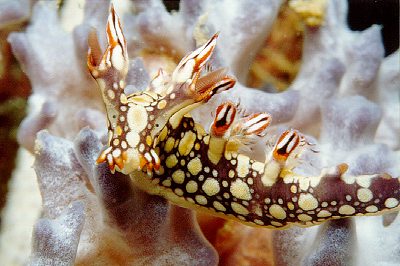
This is a very beautiful nudi I photographed at Batam, Indonesia. In one the lower photo, when the nudi look straight ahead there are 2 dots that looks like their eyes, so cute.
Depth: 10m
Size: 20cm
Date: 19/10/02
Regards,
Alice
alee@dlink.com.sg
Lee, A., 2002 (Nov 6) Bornella anguilla from Batam, Indonesia. [Message in] Sea Slug Forum. Australian Museum, Sydney. Available from http://www.seaslugforum.net/find/8326Thanks Alice,
Yes this is Bornella anguilla and the little black spots are indeed its eyes.
Best wishes,
Bill Rudman
Bornella anguilla from Queensland
February 7, 2002
From: Carle Parkhill

Bill,
Is it normal to see so many mantles on a Nudibranch? Shot taken on Flinders Reef, off Moreton Island, [Queensland, Australia] at a depth of six meters.
Carle Parkhill
carlesam@kawana.aunz.com
Parkhill,C., 2002 (Feb 7) Bornella anguilla from Queensland. [Message in] Sea Slug Forum. Australian Museum, Sydney. Available from http://www.seaslugforum.net/find/5796Dear Carle,
When you mention 'mantles' I guess you are referring to the set of 'cerata' or 'dorsal processes' down each side of the body. This sort of structure occurs in many different nudibranchs and related sea slugs. True cerata are found in the aeolid nudibranchs and if you have a lok at the page I have highlighted you will see they have quite an important function in those animals. In species of Bornella they don't have the same defensive function but they usually have a number of gills attached to them so I guess bretaing and gas exchange is an important function.
As to what is a mantle? In shelled snails the mantle is a specialised flap of skin that produces the shell. In shell-less slugs that function is a bit superfluous, but its a name given to the skin on the back of the slug. It seems from studies of the embryo that it is indeed part of the ancestral mantle, but we often just refer to the back of a slug as the 'dorsum'. Both terms often appear in the same paragraph.
Best wishes,
Bill Rudman.
Bornella anguilla from Fiji
July 18, 2001
From: Ken Tucker

I'm having trouble identifying these nudibranch, shot in Fiji this March. Perhaps you can help. It was between 1.0 - 1.5 inches long and found while diving at North Save-a-Tack Passage on the Northeast stretch of the Namena Barrier Reef, 30 miles SSW of Savu Savu on Vanua Levu
Thanks much,
Ken
ken@kilili.com
Tucker, K., 2001 (Jul 18) Bornella anguilla from Fiji. [Message in] Sea Slug Forum. Australian Museum, Sydney. Available from http://www.seaslugforum.net/find/4824Dear Ken,
This is Bornella anguilla. As well as having a spectacular 'mosaic tile' colour pattern, this species swims with an eel-like wriggle caused by a muscle wave travelling along the body. Its name 'anguilla' from 'eel' comes from this behaviour. Most species of Bornella can swim but other species have a much more clumsy non-directional flapping movement created by a simple lateral flexion of the body from side to side.
Best wishes,
Bill Rudman
Bornella anguilla from North West Australia
May 23, 2001
From: Drew Taylor

Dear Bill,
I have attached a photo of Bornella anguilla that was taken in Lighthouse Bay, Exmouth, North Western Australia on 8th May 2001.
Such a beautiful creature and a pleasure to watch it swim.
Depth: 14 metres
Size : 50mm
Regards
Drew Taylor
orcaunderwater@nwc.net.au
Taylor, D., 2001 (May 23) Bornella anguilla from North West Australia. [Message in] Sea Slug Forum. Australian Museum, Sydney. Available from http://www.seaslugforum.net/find/4331Thanks Drew,
Bill Rudman
Bornella anguilla from South Africa
May 28, 2000
From: Valda Fraser

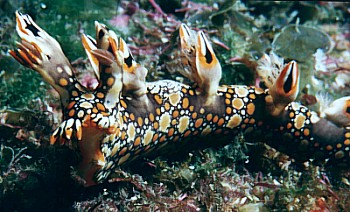
Dear Bill
A new Bornella, or maybe a variation?
Whatever it is, it is magnificent!
Locality: Scottburgh - 20m - south coast KwaZulu-Natal, SOUTH AFRICA.
Date: 21 May 2000
Size: 80mm
Regards
Valda Fraser
dlibrary@mweb.co.za
Fraser, V., 2000 (May 28) Bornella anguilla from South Africa. [Message in] Sea Slug Forum. Australian Museum, Sydney. Available from http://www.seaslugforum.net/find/2456Dear Valda,
Yes this is indeed a spectacular animal. Its name is Bornella anguilla which means the 'eel Bornella', a reference to its swimming behaviour.
Best wishes,
Bill Rudman.
